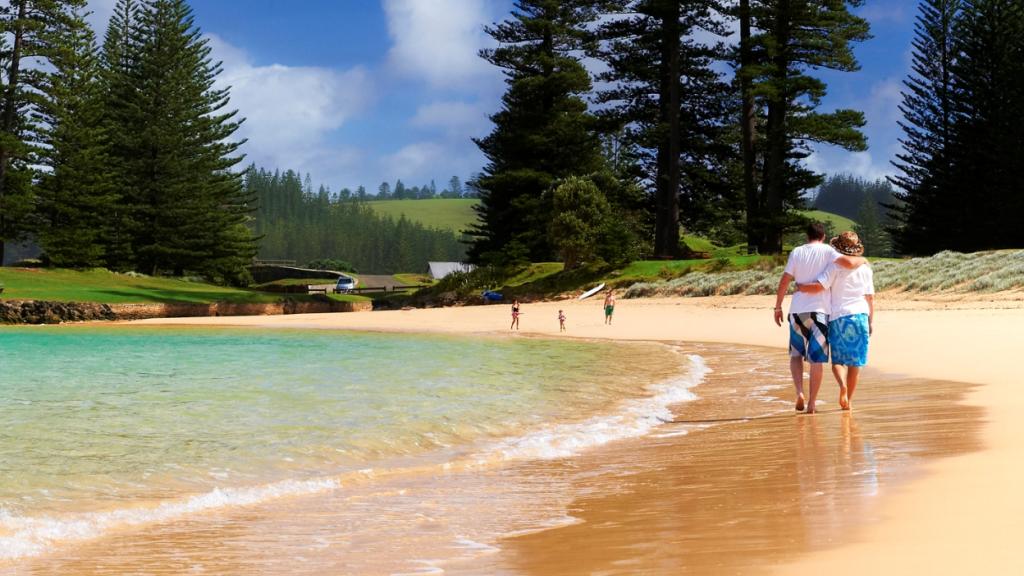
Norfolk Island has a unique geography with a small population. The primary industry on Norfolk is tourism and the government is independent of Australia in most respects except for policing, defence and education. Norfolk Island is a tax free haven of Australia.
More information for Flora and Fauna, Norfolk Language, Beach Guide and Beach & Sun Safety.
Norfolk Island is a 3855ha, 8km x 5km, three million year old volcanic outcrop located in the South Pacific Ocean, approximately 1000 kilometres east of the Australian coast, 1670kms ENE of Sydney, 1065kms NNW of Auckland and 772kms SE of Noumea. It is almost at the same latitude (29 02 S, 167 57 E) as Australia's most easterly point, Byron Bay. Norfolk's highest point is Mount Bates at 319 m.
Norfolk Island has two uninhabited neighbours just off its southern shore. About a kilometre offshore lies Nepean Island - a small islet of coral and sandstone which provides a haven for thousands of seabirds. Much of Kingston is built from blocks quarried there by Lieutenant King's convicts. Phillip Island - 6 kilometres south of Point Hunter - is a volcanic mass rising to 300 metres at its highest point.
Norfolk's sub-tropical climate is tempered by the surrounding sea. The temperatures range from 19C to 28C in the height of Summer and 12C to 19C in Winter. Click Here for up to the minute weather information.
Norfolk's tap water is clean and safe to drink unless otherwise stated. Most drinking water is rain water collected in tanks and some hotels rely upon bore water as their primary source of drinking water.
Australian Commonwealth Customs and Quarantine laws do not extend to Norfolk Island, however, local Territory laws apply. A local customs duty is imposed on most items entering the Territory. Some exemptions exist. Quarantine controls generally mirror those on the mainland. Imports of fruit, vegetables, flowers and seeds are prohibited as are pork and poultry from New Zealand.
Norfolk Island time is 11.5 hours ahead of Greenwich Mean Time (GMT), 1.5 hours ahead of Australian Eastern Standard Time, half an hour ahead of Eastern Daylight Saving Time and 1.5 hours behind New Zealand.
A passport is preferred, however photographic identification is acceptable for Australian Residents only. If travelling from New Zealand a passport is required. Australian passport holders do not require a Visa.
Public WiFi access areas are avaialble around the island. Visitors can also purchase a tourist mobile plan from Customer Care office at the Council building in Burnt Pine if required.
240 volts AC, 50 cycles, three flat pin plug. Electricity is generated locally by large diesel generators and power surges are common so the use of surge protection devices is recommended for all electronic equipment, especially computers and modems.
Australian currency is used on Norfolk Island. Credit cards are also accepted.
Tipping is not expected on Norfolk Island, however, it is customary so if you are happy with someone who has tried that little bit harder and gone the extra mile, then a tip is in order and always appreciated. Giving a small tip (10% of the bill) in a restaurant is in order if the service is good.
A taxi service is available on the Island, however, you can not simply flag one down - you will have to book a taxi in advance if you want to go anywhere. There is no public transport on the Island but small rental cars are plentiful.
Cars drive on the left hand side of the road. Look out for cows, they have free run of the Island (except in the town centre) and they have right of way - it is an offence to hit a cow and you will be fined if you do.
The temperature on Norfolk Island, on average, ranges from 19C to 28 C in summer to 12C to 19C in winter. The seasons on Norfolk Island are :
Spring : September - November
Summer : December - February
Autumn: March - May
Winter : June - August